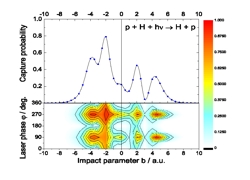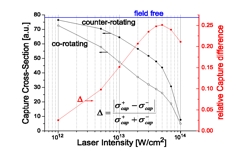Electron capture and ionization in laser-assisted ion-atom collisions
Thomas Niederhausen, Uwe Thumm
J R. Macdonald Laboratory, Kansas State University, Manhattan, Kansas 66506 USA
It has been shown theoretically, that the presence
of a strong laser field (above 1012 W/cm2)
can significantly alter electron capture and ionization
probabilities in ion - atom collisions [1, 2, 3].
We have found a circular dichroism
in the electron capture probability for proton
- hydrogen-atom collisions in the presence of
circularly polarized laser light, using a two-
dimensional model of the scattering process to
solve the time-dependent Schrodinger equation
on a numerical grid, where the electron is confined
in the scattering plane which also includes
the laser electric field vector. In this scenario
we have shown, that the capture and ionization
probabilities crucially depend on the impact parameter
and the absolute laser phase at the time
of the collision (Fig. 1). In particular, we find
an interesting strong dependence of the ionization
probability on the impact parameter and the
laser phase.
The dichroism effect for capture, as expressed
in terms of the relative difference Δ of cross sections
for left and right circular polarized light (i.e.
co- versus counter-rotating laser electric field and
internuclear axis), is largest for a laser intensity
of 5 x 1013 W/cm2 (Fig. 2).
We will discuss full 3-dimensional results of
the laser-assisted collision in comparison with
other theoretical approaches, such as the non-perturbative
basis-generator method [1], time-dependent scattering
theory [2], and grid-models of reduced dimensionality [3].

Figure 1: Electron capture probability for proton-hydrogen collisions in a circular
polarized laser field as a function of the impact parameter and the laser phase at
the time of closest approach (laser intensity 5x1013 W/cm2,
wavelength 1064 nm, projectile energy 1.21 keV).

Figure 2: Co- and counter-rotating total electron capture cross sections
and their relative difference Δ as a function of the laser intensity.
References:
[1] T. Kirchner, Phys. Rev. A 69, 063412 (2004).
[2] S. M. Li, J. Chen, and Z. F. Zhou, J. Phys. B 35, 557 (2002).
[3] T. Niederhausen, B. Feuerstein, and U. Thumm, Phys. Rev. A 70, 023408 (2004).
This work is supported by NSF and US DoE.
Submitted to ICPEAC, July 2005 in Rosario, Argentina.
This abstract is also available in
Adobe Acrobat format.

